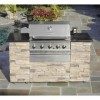Kenmore SI3209ZA Use and Care Guide - Page 35
Use a heat resistant Stainless Steel Cleaner - review
 |
View all Kenmore SI3209ZA manuals
Add to My Manuals
Save this manual to your list of manuals |
Page 35 highlights
Question: The Regulator and Hose supplied with my gas grill does not fit the older LP Gas tank I've used for years. Why not? Answer: The U.S. Government regulates gas appliances and LP Gas tanks. When regulations are changed the LP Gas tank fittings are altered to insure compliance. If your LP Gas tank does not fit the Regulator and Hose supplied with your new grill, the tank is outdated and must be replaced. Note: Effective April 1, 2002 alI LP Gas tanks sold must include an "OPD" Overfill Prevention Device. The OPD tanks are identified by their triangular-shaped valve wheel. This internal device prevents the LP Gas tank from being overfilIed. Tanks without an OPD valve can not be refilled. Question: What causes grill parts to rust and what affect does it have on my grill? Answer: Rusting is a natural oxidation process and will not affect the short term performance of your grill. To slow the rusting process on Cooking Grids we recommend greasing the grids before and after each cookout. Use a brush to apply a thin layer of cooking oiI or vegetable shortening onto each grid. We do not suggest spray type oils unless they are specified for high-temperature cooking. If your Cooking Grids are Porcelain coated, be sure to coat the entire cooking surface including edges and any areas with chipped porcelain. Routine care and maintenance is required to preserve the appearance and corrosion resistance of stainless steel. The fact is stainless steel can corrode, rust and discolor under certain conditions. Rust is caused when regular steel particles in the atmosphere become attached to the stainless steel surface. Steel particles can also become attached to your grill if you use steel wooI or stiff wire brushes to clean the grill instead of non-abrasive cloth, sponge or nylon cleaning tools. In coastal areas rust pits can develop on stainless surfaces that cannot be fully removed. Bleach and other chlorine based solutions used for household and pool cleaning can also cause corrosion to stainless steel. Weathering, extreme heat, smoke from cooking and machine oils used in the manufacturing process of stainless steel can cause stainless steel to turn tan in color. Although there are many factors which can affect the surface appearance of stainless steel, they do not affect the integrity of the steel or the performance of the grill. To help maintain the finish of stainless steel follow these cleaning procedures for the best results: After every use (after your grill has cooled down), wipe stainless surfaces with a soft, soapy cloth or sponge then rinse with water. Be sure to remove all food particles, sauces or marinades from stainless steel because these can be highly acidic and damaging to stainless surfaces. Never use abrasive cleaners, scrubbers or stiff wire brushes of any type on your grill. Use a heat resistant Stainless Steel Cleaner and rub or wipe in the direction of the stainless steel grain or polish lines NOT against the grain. Question: Which is a better cooking surface to grill on; porcelain coated steel / cast-iron cooking grids or stainless steel grids? Answer: They all have their advantages. For traditional grilling and searing meats, cast-iron or steel grids offer better heat conductivity. To protect against the natural rusting process, steel or cast-iron cooking grids offer a porcelain finish which requires routine maintenance to keep the grids welI seasoned. Stainless steel is popular with those who prefer less maintenance. A new innovative solution is available on select models called Stainless Clad Therma-Core c_.This Cooking Grid combines a heat conducting steel core with an easy-to-clean stainless outer shell. You may also review FAQ's, Troubleshooting and Care & Maintenance Tips online at www.qrandhall.com. A-8















